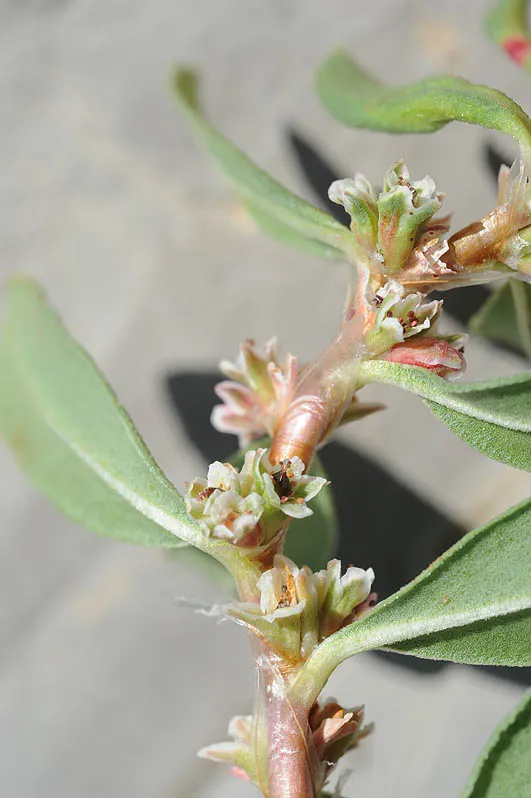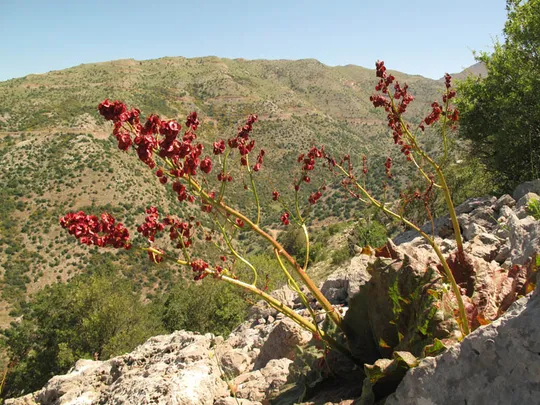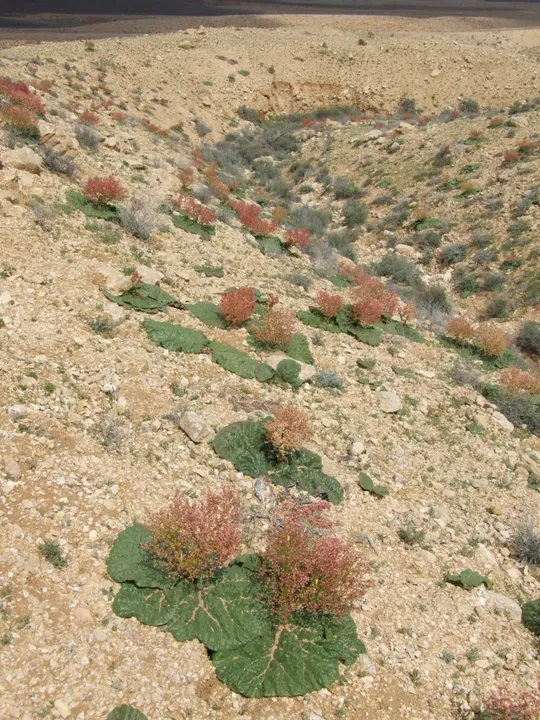Sea Knotgrass, Sea Knotweed
Polygonum maritimum
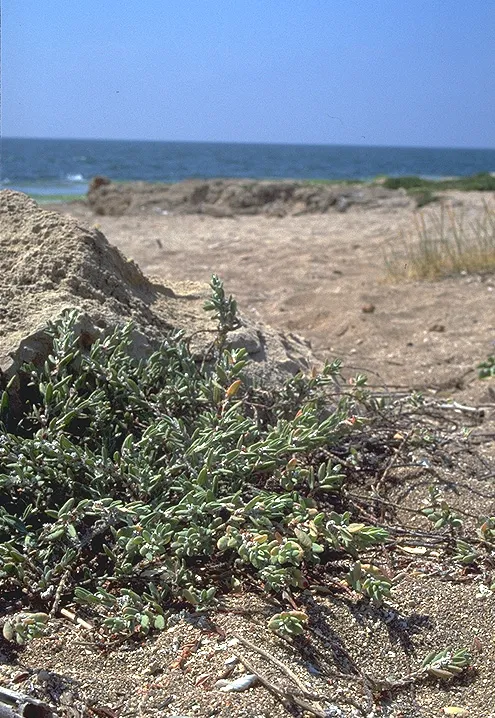
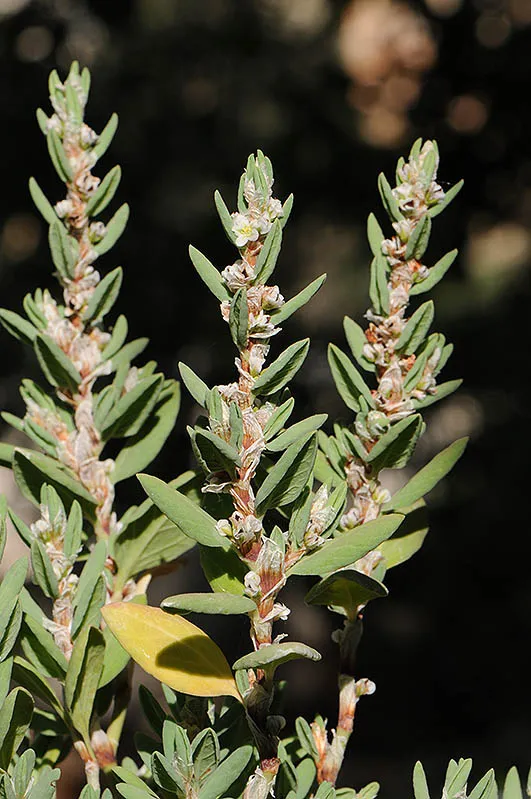
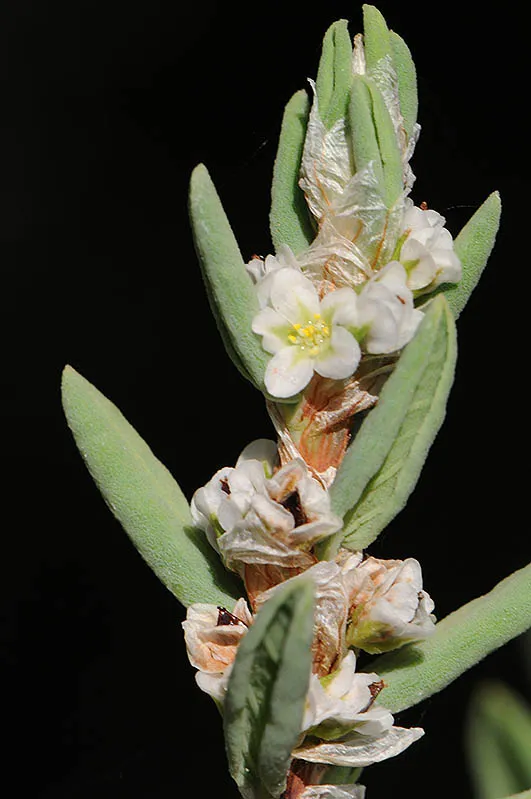
Polygonum maritimum is a perennial plant with a spreading prostrate rhizome, 15-30 cm across that grows on coastal sands. Its wide elliptical-lanced leaves are much larger, 1.5-3.5 cm long, than the leaves of other closely related species. Each section of the stem is enveloped in a large sheath roughly half the length of the leaf. The sheath is composed of papery stipules joined together that envelop the stem. Flowers pink to white, with five petals, eight stamens, a single style that splits into 2-3 lobes, and one ovule that ripens to a seed. The fruit is a large nutlet that protrudes from the perianth.
Polygonum maritimum currently grows only in the Acre Valley and on the
Carmel Beach. Formerly it was also found in the Sharon and Philistean
Plain regions. At the end of 1980s small populations of the species were
surveyed in section between Herzliya and Tel Aviv (Tel Mikhal and Tel
Barukh), but in 2002 it became clear that all the populations in this
section were extinct. The Acre valley sites are located mainly on the
Shave-Tsion, Nahariya and Akhziv beaches. In these regions, many
populations numbering tens and hundreds of plants were counted. The
total population is estimated at 2500. On the Carmel beach P. maritimum
is found on several coastal sites from Shikmona in the north to Ma’ayan
Tsvi in the south. Some of these sites were discovered only in the
1980s and 1990s. The rare species survey conducted in the region in 1994
found populations with very few specimens. Since there are reports that
the number of sites is decreasing due to extensive human activity on
the beach, and possibly because of population extinction due to the
small number of plants. Another population was found in 2005 on the
coast of Tel Katifa in the Gaza Strip.
Sandy areas on the spray zone on the beach, usually on sandy strips bordering the sea and not further than 80 meters from the shoreline.
The genus Polygonum numbers 200 species found throughout the world, but its origin is in the Northern Hemisphere. Most of the species are weeds or aquatic plants, annual and perennial herbaceous species.
There is a tendency to divide the genus into a number of separate genera, thus Persicaria senegalensis and a number of close species were separated into the genus Persicaria. Thus the genus Polygonum in the narrow sense includes only 20 species.
P. maritimum differs from most Polygonum species in Israel in its very wide elliptic leaves, and in its flowers that are scattered in the axils homogeneously and not concentrated at the stem head as an inflorescence. In addition, its ochreola is unusually long and conspicuous. It is difficult to surmise to whom P. maritimum is closest to, but it may possibly be that P. polycnemoides from the Hermon is a vicarious species. A similar pattern of a coastal species close to a steppe-mountainous species is found in the genera Glaucium, Eryngium and Euphorbia. It may be related to the stress conditions and disturbances in coastal habitats
• The development of beaches for recreation and bathing is the most serious threat factor to Polygonum maritimum in Israel.
• The P. maritimum sites are fragmented, hundreds of meters to a few kilometers apart.
• On some sites, individual plants were found, but in the Acre Valley (on the coast north of Nahariya) populations of 1000-2000 of were observed.
• The threat is increasing in many countries along the Mediterranean coast due to beach development.
• P. maritimum is located in the Akhziv, Rosh HaNikra and Bustan HaGalil (proposed) reserves.
The Carmel coast populations should be protected and the Shikmona beach preserved (as part of the proposed reserve).
Polygonum maritimum grows in all the countries around the Mediterranean basin, in the north and in the south (the coasts of Libya, Tunis, Egypt). Penetrates deeply to the Atlantic shores of Europe and is also found in the Azores. It grows on the shores of the Black Sea as well.
The species has also been recorded in South America (probably an immigrant population – Flora Palaestina, 1966).
Polygonum maritimum is a rare plant limited to only a few sites in a very unique habitat – mainly on sandy beach strips, where it is being destroyed because of development for recreation and bathing. Its habitat is seriously threatened due to extensive human activities on the beach. Therefore, the species is in immediate danger of extinction in Israel, and should be prioritized for conservation. The largest P. maritimum population that grows on the coast north of Nahariya should be monitored at least one population should be protected in a nature reserve.
Current Occupancy Map
| 1000 squre meter pixel | 5000 squre meter pixel | 10000 squre meter pixel | |
|---|---|---|---|
| number of observations | 0 | 0 | 0 |
| in total pixels | 0 | 0 | 0 |
| Family | Polygonaceae |
| Classification | On the endangered species list |
| Ecosystem | Coastal area |
| Chorotype | Western Euro– Siberian and Mediterranean |
| Conservation Site | North Nahariya Beach |
| Rarity |
1
2
6
|
|---|---|
| Vulnerability |
0
4
4
|
| Attractiveness |
0
0
4
|
| Endemism |
0
0
4
|
| Red number |
1
3.7
10
|
| Peripherality | N |
| IUCN category | DD EW EX LC CR EN VU NT |
| Threat Definition according to the red book | Vulnerable |
 Based on:
Based on:
